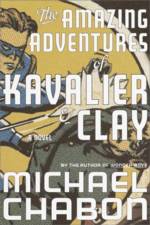Michael Chabon


| Click on a book's image or title to order from Amazon.com |

The Amazing Adventures of Kavalier and Clay
Random House, © 2000, 636 pp, ISBN #0-679-45004-1Reviewed June 2001
A tour de force of the Golden Age of comic books, The Amazing Adventures of Kavalier and Clay is the much-lauded story of two Jewish boys in 1939 New York who create the superhero The Escapist and prompt the founding of Empire Comics to compete alongside Superman and Captain America. Sam Clay is a polio survivor with larger-than-life dreams, and his cousin Joe Kavalier is a refugee from Nazi-occupied Czechoslovakia who can draw, pick locks, and who dreams of rescuing his family from the Nazis.
In contrast to the four-color newsprint pamphlets which Kavalier and Clay create, Chabon tells their story in dense, often florid, prose. A common stylistic tic of the novel is to enter into a scene after it's already occurred and then explore it after seeing the outcome (in a sense the whole novel is treated this way, as Chapter One begins with Sam Clay remembering creating the escapist decades later), or to enter a scene and then provide a lengthy digression about the background of one of the characters being introduced. Sometimes this technique is charming, other times it feels superfluous. However, you have you deal with it to read the book.
The amount of research which went into Kavalier and Clay is impressive, ranging from magic techniques to World War II-era Prague and New York, to the Golden Age of comic book publishing, to classy-but-fringe society in New York in that era, to obscure theatres in World War II. Little of it is truly squandered. Best of all, the book lives up to its title, as much of it does concern the "amazing adventures" of its protagonists, as they sell their ideas, recruit people to assist them, and help to build an Empire.
However, the book works at cross purposes with itself in several ways. Fundamental among these is that it's never clear whether it's supposed to be Sam Clay's story or Joe Kavalier's story, and it feels too slanted towards Kavalier to belong to both of them. Yet Kavalier doesn't feel like a fully rewarding protagonist; Sammy, despite his flaws, often feels like the character you really want to get behind: A con man on the surface, but a complex and honest one at his core. We never quite see enough of him to be entirely satisfying.
Joe is the more exotic of the two, and we're treated to several months of his life in Prague, studying magic and then trying to escape from the Nazis. Later we see his feelings as he works to get his brother out of occupied Europe, and then his days in the military when he finally feels unstoppably moved to take his feelings to the Nazis themselves. But Joe is also a damaged human being, finding it difficult to express what he feels, and doing so off-panel (as it were) when he does express them.
The book also struggles to find the right balance between focusing on its characters and on their unusual setting. A fair amount of time is spent exploring the comic book industry of the era, including a brief aside about how comic books were produced. We see the struggles Joe and Sammy face to produce the comics they want (and in Joe's case, need) to produce, and to be fairly compensated for their efforts. As the 30s fade into the 40s and 50s, the travails of the industry during the McCarthy era (when the restrictive Comics Code Authority was imposed on most publishers, to the - deliberate - ruination of one of the most innovative of the era, EC Comics) are also shown, as well as how they impact our heroes' lives.
But Joe and Sammy also have substantial inner demons to face (Sammy's might be patently obvious to some early on, though it was a head-smacking surprise to me when it was revealed, so I'll keep it secret here so as not to spoil the pleasure of being stunned for a few who read this who might be). At the beginning, Joe's troubles are the foremost ones, but once they mutate into a different form, and once Sammy's come to light, the book diffuses considerably. Joe falls in love with abstract artist Rosa Saks, and they and Sammy end up in a decidedly unusual love triangle. But while Sammy seems able to come to grips with his issues in his own way, his revelation comes at a price whose impact is never fully revealed. Worse, Joe's ultimate salvation (or otherwise) is left fairly murky. I was not convinced at the end that he'd exorcised his demons, given his past behavior.
And that's the most disappointing part of the book: The ending isn't very satisfying. It leaves things unsaid about the characters, and it also leaves decades of history ahead of them which - based on how the industry evolved in the 60s, 70s and 80s - could have had a profound impact on their lives. Sure, one could point to the figures who were the source material for Sammy (Stan Lee and Gardner Fox) and Joe (Jack Kirby, perhaps Will Eisner) and trace their lives as ones that Sammy and Joe might have followed, but that doesn't really cut it. They're not really the same people. Perhaps this would only matter to comic book fans versed in the medium's history, but to me the book almost demands a sequel.
But it's still a very good book, for all its rough edges. The narrative is entertaining and at times breathtaking, its outlook on its characters is decidedly humanistic, the historical detail is intriguing, and most of all it's just fun. It feels like it could have been more... but then, couldn't they all?
hits since 10 June 2001.